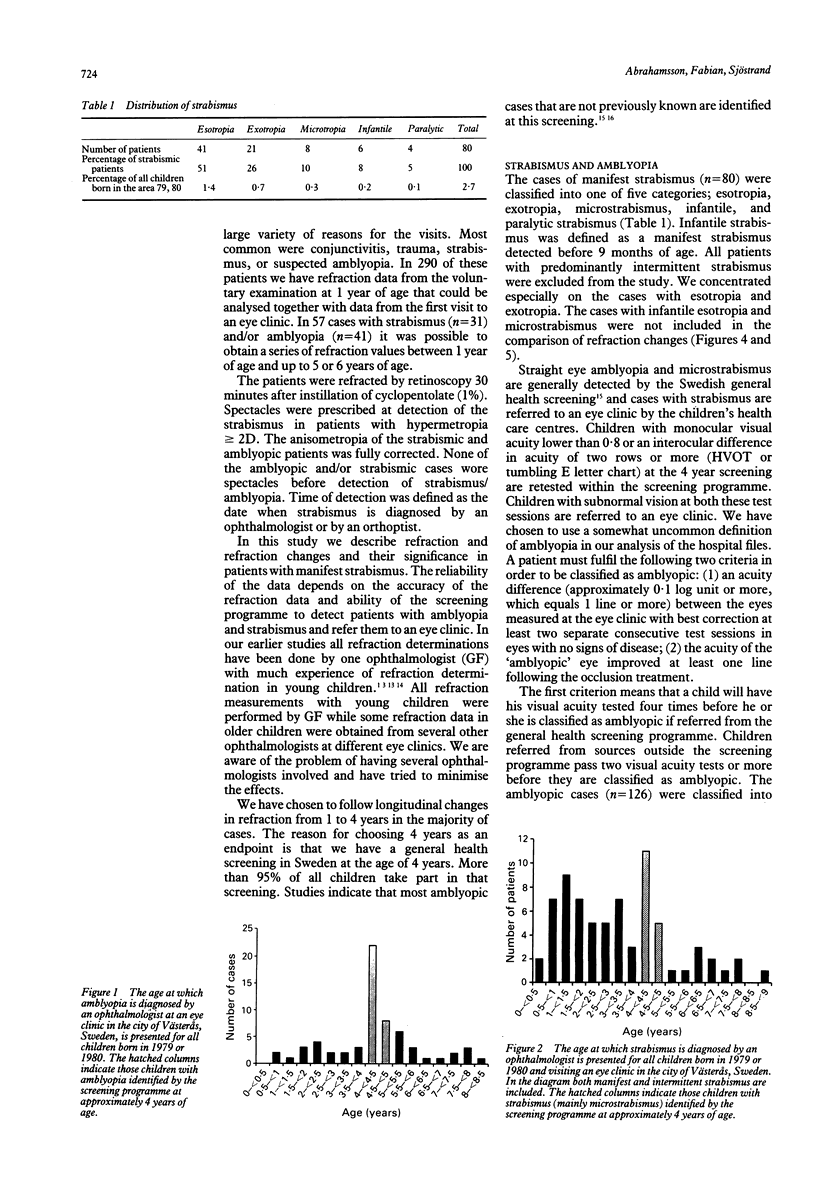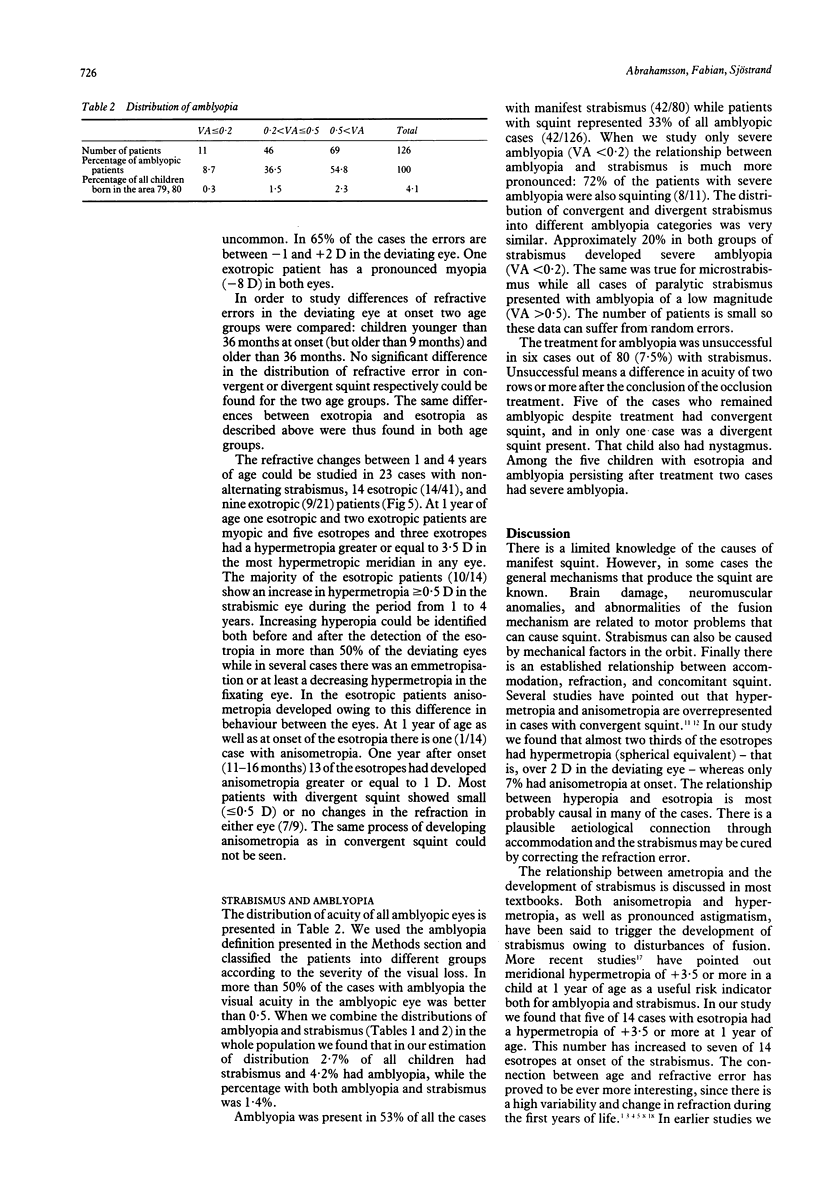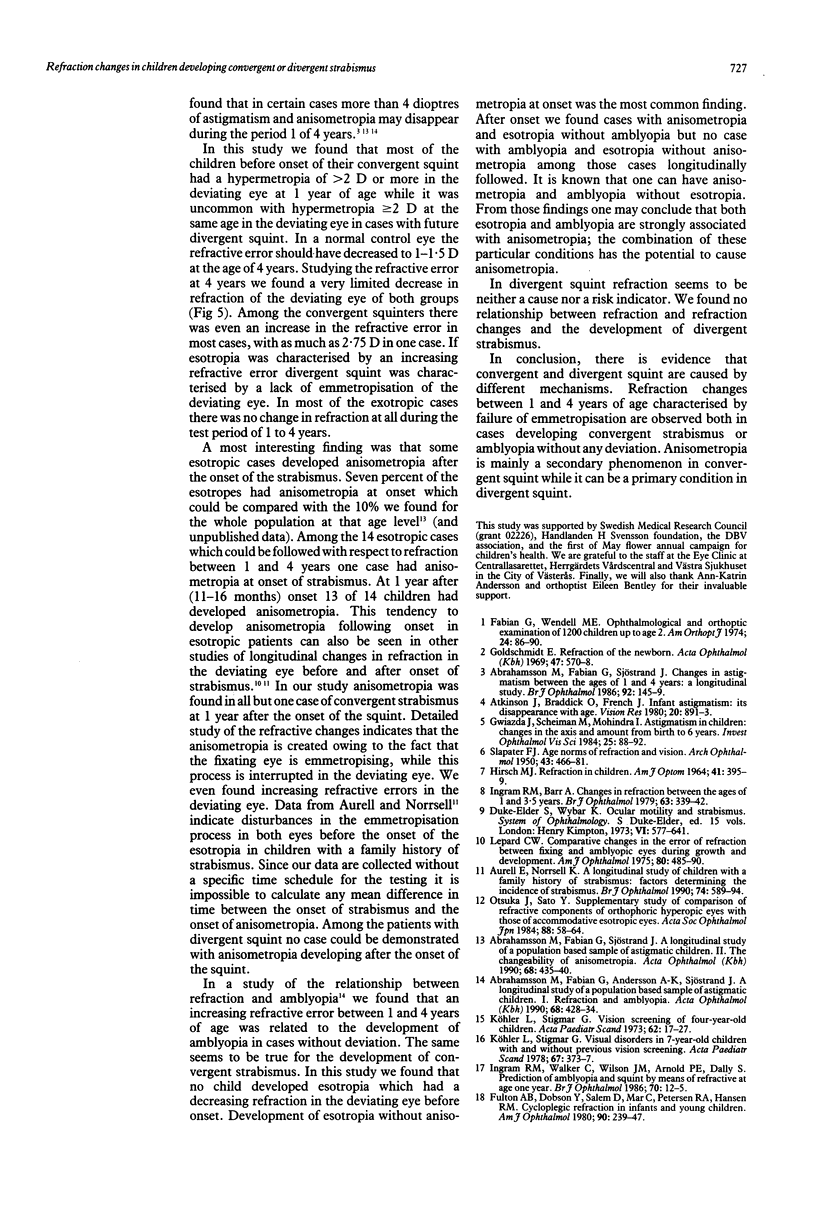Abstract
Strabismus and amblyopia were studied in a cohort of children born in 1979 or 1980 in the area of Västerås, Sweden. Forty percent of the children had participated in a voluntary eye examination at 1 year of age. All children diagnosed as strabismic and/or amblyopic between 1979 and 1988 at any of the three eye clinics in the area were included in this study. Strabismic cases were mostly detected by the parents while microstrabismus and straight eye amblyopia were found at the general 4 years of age screening at children's health centres. In 57 cases with (n = 31) and without amblyopia (n = 41) it was possible to obtain several refraction values between 1 and 6 years of age. In this study we concentrated on manifest esotropia and exotropia. The aim of the study was to describe changes of refraction before and after onset of strabismus and to establish risk indicators that identified populations at risk of developing strabismus. We found that patients with esotropia show a more pronounced hypermetropia than exotropic cases at the time of detection of strabismus. This difference becomes more definite over time, since hypermetropia increased in the deviating eye in the esotropic cases while refractive errors remained stationary in most of the exotropic eyes. It was also apparent that anisometropia frequently developed after onset of strabismus in esotropic cases in contrast to exotropic cases. An increasing refractive error in the deviating esotropic eye could be combined with an emmetropisation of the fixating eye.
Full text
PDF




Selected References
These references are in PubMed. This may not be the complete list of references from this article.
- Abrahamsson M., Fabian G., Andersson A. K., Sjöstrand J. A longitudinal study of a population based sample of astigmatic children. I. Refraction and amblyopia. Acta Ophthalmol (Copenh) 1990 Aug;68(4):428–434. doi: 10.1111/j.1755-3768.1990.tb01671.x. [DOI] [PubMed] [Google Scholar]
- Abrahamsson M., Fabian G., Sjöstrand J. A longitudinal study of a population based sample of astigmatic children. II. The changeability of anisometropia. Acta Ophthalmol (Copenh) 1990 Aug;68(4):435–440. doi: 10.1111/j.1755-3768.1990.tb01672.x. [DOI] [PubMed] [Google Scholar]
- Atkinson J., Braddick O., French J. Infant astigmatism: its disappearance with age. Vision Res. 1980;20(11):891–893. doi: 10.1016/0042-6989(80)90070-x. [DOI] [PubMed] [Google Scholar]
- Aurell E., Norrsell K. A longitudinal study of children with a family history of strabismus: factors determining the incidence of strabismus. Br J Ophthalmol. 1990 Oct;74(10):589–594. doi: 10.1136/bjo.74.10.589. [DOI] [PMC free article] [PubMed] [Google Scholar]
- Fabian G., Wendell M. E. Ophthalmologic and orthoptic examination of 1,200 children up to age 2. Am Orthopt J. 1974;24:86–90. [PubMed] [Google Scholar]
- Fulton A. B., Dobson V., Salem D., Mar C., Petersen R. A., Hansen R. M. Cycloplegic refractions in infants and young children. Am J Ophthalmol. 1980 Aug;90(2):239–247. doi: 10.1016/s0002-9394(14)74861-5. [DOI] [PubMed] [Google Scholar]
- Goldschmidt E. Refraction in the newborn. Acta Ophthalmol (Copenh) 1969;47(3):570–578. doi: 10.1111/j.1755-3768.1969.tb08143.x. [DOI] [PubMed] [Google Scholar]
- Gwiazda J., Scheiman M., Mohindra I., Held R. Astigmatism in children: changes in axis and amount from birth to six years. Invest Ophthalmol Vis Sci. 1984 Jan;25(1):88–92. [PubMed] [Google Scholar]
- HIRSCH M. J. REFRACTION OF CHILDREN. Am J Optom Arch Am Acad Optom. 1964 Jul;41:395–399. doi: 10.1097/00006324-196407000-00001. [DOI] [PubMed] [Google Scholar]
- Ingram R. M., Barr A. Changes in refraction between the ages of 1 and 3 1/2 years. Br J Ophthalmol. 1979 May;63(5):339–342. doi: 10.1136/bjo.63.5.339. [DOI] [PMC free article] [PubMed] [Google Scholar]
- Ingram R. M., Walker C., Wilson J. M., Arnold P. E., Dally S. Prediction of amblyopia and squint by means of refraction at age 1 year. Br J Ophthalmol. 1986 Jan;70(1):12–15. doi: 10.1136/bjo.70.1.12. [DOI] [PMC free article] [PubMed] [Google Scholar]
- Köhler L., Stigmar G. Vision screening of four-year-old children. Acta Paediatr Scand. 1973 Jan;62(1):17–27. doi: 10.1111/j.1651-2227.1973.tb08060.x. [DOI] [PubMed] [Google Scholar]
- Köhler L., Stigmar G. Visual disorders in 7-year-old children with and without previous vision screening. Acta Paediatr Scand. 1978 May;67(3):373–377. doi: 10.1111/j.1651-2227.1978.tb16337.x. [DOI] [PubMed] [Google Scholar]
- Lepard C. W. Comparative changes in the error of refraction between fixing and amblyopic eyes during growth and development. Am J Ophthalmol. 1975 Sep;80(3 Pt 2):485–490. doi: 10.1016/0002-9394(75)90212-3. [DOI] [PubMed] [Google Scholar]
- Otsuka J., Sato Y. [Comparison of refraction in orthophoric hyperopic eyes and accommodative esotropic eyes]. Nippon Ganka Gakkai Zasshi. 1984 Jan;88(1):58–64. [PubMed] [Google Scholar]


